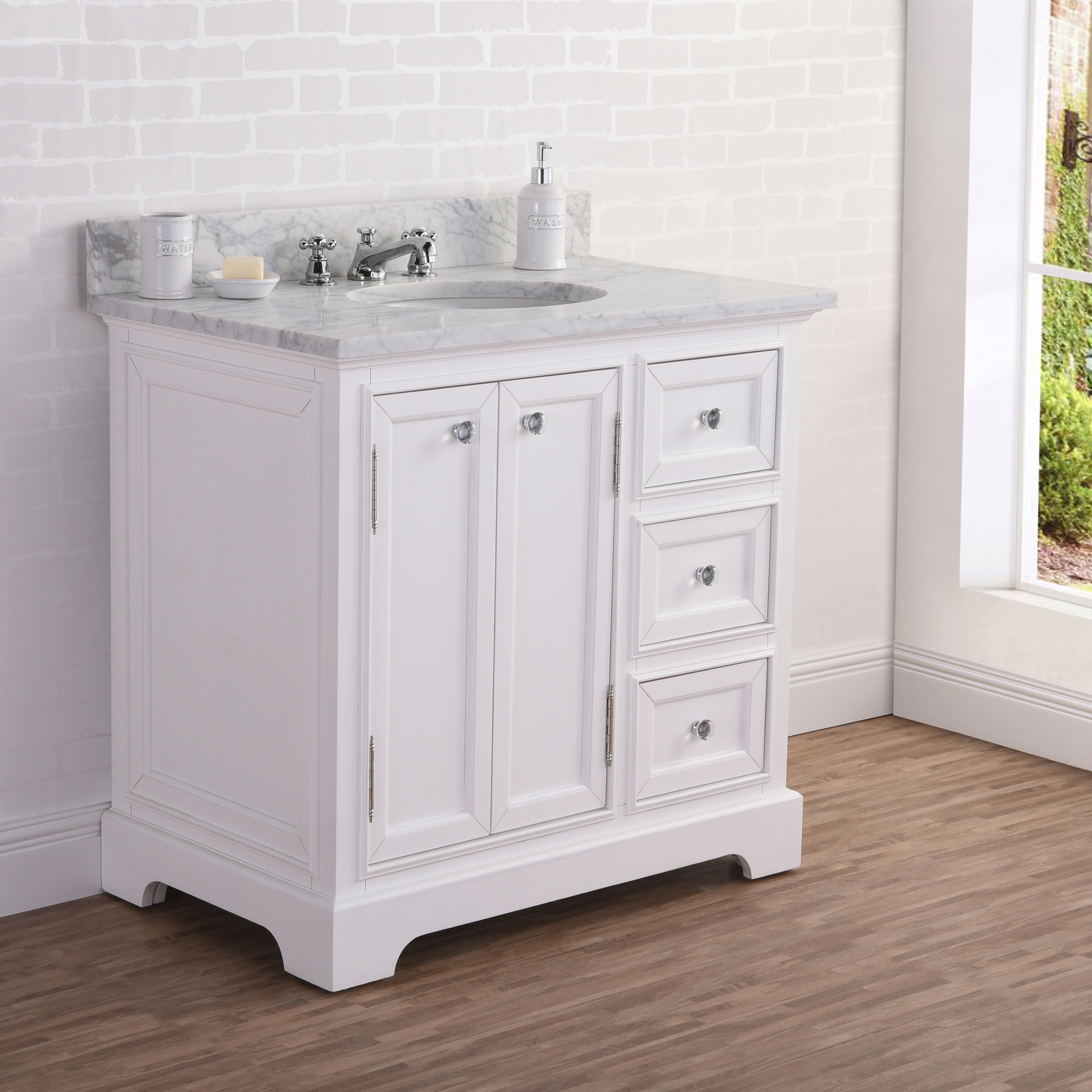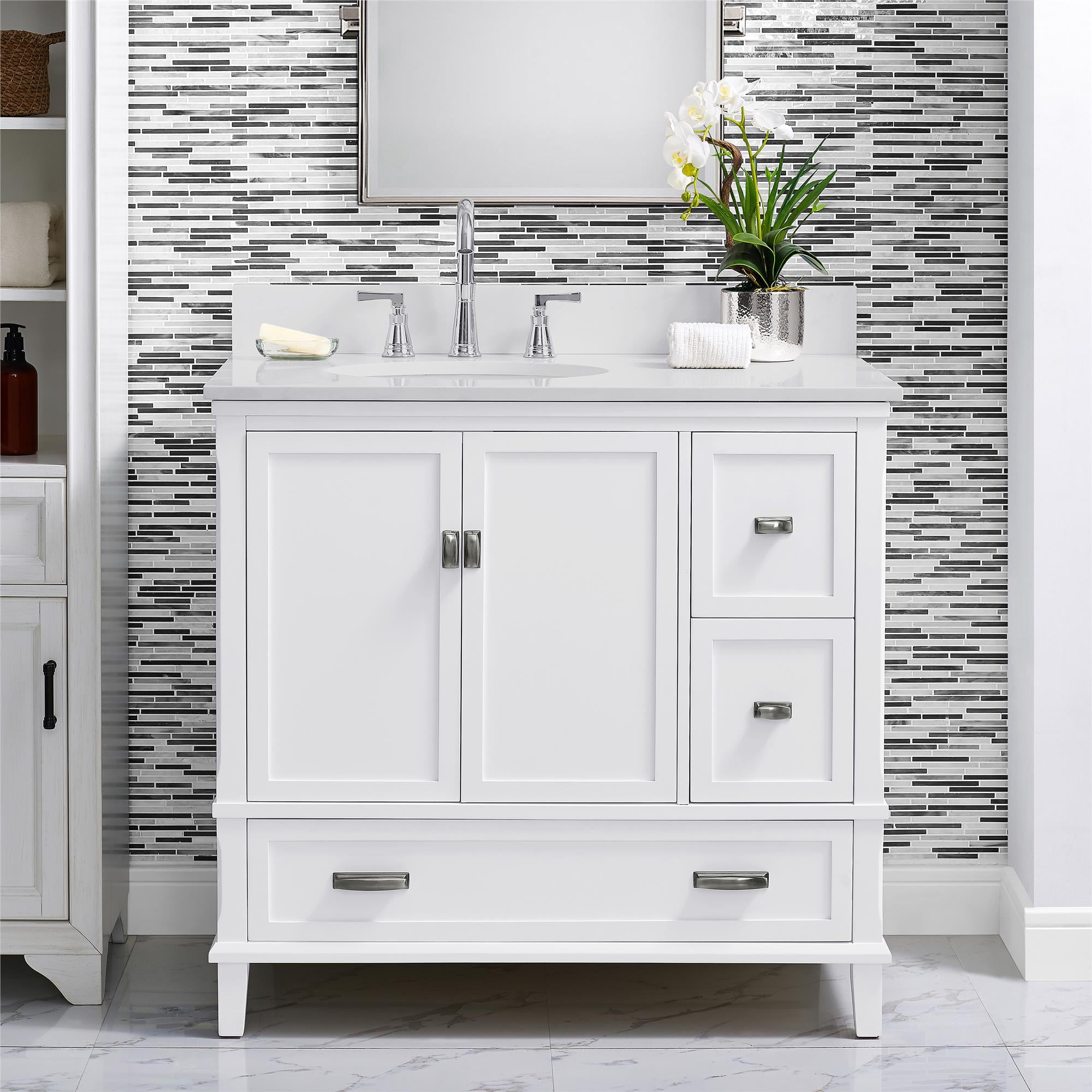The Appeal of a 36-Inch Floating Bathroom Vanity

Floating vanities are a popular choice for modern bathrooms, offering a sleek and contemporary look while maximizing space. A 36-inch floating vanity is a particularly versatile option, providing ample storage and counter space for a variety of bathroom layouts.
Advantages of a Floating Vanity
Floating vanities offer a number of advantages over traditional bathroom vanities, making them a desirable choice for many homeowners.
- Space-Saving Design: Floating vanities create a sense of openness and spaciousness in a bathroom, as they don’t require legs or a base to rest on. This makes them ideal for smaller bathrooms or those with limited floor space.
- Easy Cleaning: The open space underneath a floating vanity allows for easy cleaning, as there are no legs or base to obstruct access. This makes maintaining a clean and hygienic bathroom much easier.
- Modern Aesthetic: Floating vanities are a hallmark of modern bathroom design, adding a touch of sophistication and contemporary flair to any space.
- Versatile Storage Options: Floating vanities can be customized with a variety of storage options, including drawers, cabinets, and open shelves, to suit individual needs and preferences.
The Benefits of a 36-Inch Vanity Size, 36 inch floating bathroom vanity
A 36-inch floating vanity is a versatile size that can accommodate a variety of bathroom layouts.
- Small Bathrooms: A 36-inch vanity provides ample storage and counter space without overwhelming a small bathroom.
- Medium-Sized Bathrooms: A 36-inch vanity can be used as a single vanity in a medium-sized bathroom or as a smaller vanity in a larger bathroom with multiple sinks.
- Large Bathrooms: A 36-inch vanity can be paired with another vanity or used as a secondary vanity in a large bathroom.
Design Aesthetic
Floating vanities offer a distinct design aesthetic compared to traditional vanities.
- Modern and Sleek: Floating vanities create a clean and contemporary look, often featuring minimalist designs and sleek lines.
- Visual Openness: The lack of a base or legs creates a sense of visual openness, making the bathroom appear larger and more spacious.
- Versatile Styling: Floating vanities can be styled in a variety of ways, from minimalist and modern to rustic and traditional, depending on the desired aesthetic.
Features and Considerations for a 36-Inch Floating Vanity: 36 Inch Floating Bathroom Vanity

A 36-inch floating vanity offers a stylish and space-saving solution for your bathroom. It’s a versatile size that can fit into various bathroom layouts, from small powder rooms to larger master bathrooms. To make the most of your 36-inch floating vanity, it’s crucial to consider the various features and design elements available.
Countertop Materials
The countertop is a prominent feature of any vanity, and choosing the right material is essential.
- Natural Stone: Marble, granite, and quartz are popular choices for bathroom vanities. They are durable, resistant to scratches and heat, and come in a wide range of colors and patterns. However, they can be expensive and require regular sealing to maintain their shine.
- Engineered Stone: Engineered stone, like quartz, is a man-made material that combines crushed stone with resins. It offers the look of natural stone but is more affordable and less porous. It’s also more resistant to stains and scratches.
- Solid Surface: Solid surface countertops, such as Corian, are non-porous and seamless, making them easy to clean. They are also available in a variety of colors and can be molded into different shapes.
- Laminate: Laminate countertops are the most budget-friendly option. They come in various patterns and colors to match your bathroom’s style. However, they are less durable than other materials and may be susceptible to scratches and water damage.
Sink Styles
The sink is an integral part of a bathroom vanity.
- Undermount Sink: Undermount sinks are seamlessly integrated into the countertop, creating a sleek and modern look. They are also easier to clean as there are no edges for dirt and grime to accumulate.
- Vessel Sink: Vessel sinks sit on top of the countertop and are often decorative. They add a touch of elegance to the bathroom but can be more difficult to clean as water can splash around the edges.
- Integrated Sink: Integrated sinks are molded into the countertop, creating a seamless and modern look. They are also very easy to clean.
Storage Options
Storage is a crucial consideration for any bathroom vanity, especially in smaller spaces.
- Drawers: Drawers provide organized storage for toiletries, towels, and other bathroom essentials. They can be shallow or deep, depending on your storage needs.
- Cabinets: Cabinets offer more storage space than drawers and can accommodate larger items. They can be open or closed, depending on your preference.
- Shelves: Shelves are a great option for displaying decorative items or storing frequently used items. They can be open or closed, depending on your preference.
Choosing the Right Materials and Finishes
The materials and finishes you choose for your 36-inch floating vanity should complement the style of your bathroom.
- Traditional Style: For a traditional bathroom, consider using natural stone countertops, such as marble or granite, in warm colors like beige, cream, or brown. Choose a vanity with ornate details, such as carved legs or decorative hardware.
- Modern Style: For a modern bathroom, opt for sleek and minimalist designs. Choose a vanity with a simple, geometric shape and a countertop made of engineered stone or solid surface. Select a sink with a clean, undermount design.
- Contemporary Style: Contemporary style bathrooms embrace clean lines and bold colors. Consider using a countertop made of solid surface or laminate in a vibrant color. Choose a vanity with a simple, geometric shape and modern hardware.
- Rustic Style: For a rustic bathroom, choose a vanity made of reclaimed wood or natural stone with a rough-hewn finish. Select a countertop made of natural stone with a distressed look. Use hardware with a rustic finish, such as iron or bronze.
Designing a 36-Inch Floating Vanity for a Small Bathroom
When designing a 36-inch floating vanity for a small bathroom, it’s essential to maximize storage and functionality.
- Vertical Storage: Utilize vertical space by incorporating tall cabinets or shelves. This will help you maximize storage without taking up valuable floor space.
- Multi-Functional Storage: Choose a vanity with a combination of drawers, cabinets, and shelves. This will provide you with versatile storage options for different types of items.
- Open Shelving: Incorporate open shelving to create a sense of openness and airiness in a small bathroom. You can use the shelves to display decorative items or store frequently used items.
- Mirrors: Mirrors can make a small bathroom feel larger. Consider using a large mirror above the vanity to reflect light and create the illusion of more space.
Installing a 36-Inch Floating Vanity

Installing a 36-inch floating vanity can be a rewarding DIY project, adding a modern touch to your bathroom. However, it requires careful planning and execution to ensure a secure and aesthetically pleasing result. This guide provides a comprehensive step-by-step process to guide you through the installation.
Tools and Materials
A successful installation requires the right tools and materials. This section lists the essential items to ensure a smooth and efficient process.
- Measuring Tape: Accurate measurements are crucial for precise placement and cutting.
- Level: Ensuring the vanity is perfectly level is essential for both aesthetics and functionality.
- Stud Finder: Locating wall studs provides a strong and secure foundation for the vanity.
- Drill: Necessary for drilling pilot holes and securing the vanity to the wall.
- Screwdriver: For attaching the vanity to the wall and assembling any components.
- Saw: For cutting the vanity baseboard or any necessary adjustments.
- Pencil: For marking the installation locations on the wall.
- Safety Glasses: Protect your eyes from debris during drilling and cutting.
- Floating Vanity: The centerpiece of your project.
- Mounting Brackets: Typically included with the vanity, these provide the primary support.
- Wall Anchors: If the vanity is installed on drywall, these will provide extra support.
- Caulk: For sealing gaps and creating a smooth, water-resistant finish.
- Silicone Sealant: For sealing around the sink and faucet, preventing leaks.
- Plumbing Supplies: Including new supply lines, a shut-off valve, and any necessary fittings.
Wall Preparation
Proper wall preparation is crucial for a successful installation. This section Artikels the steps to ensure a stable and secure base for your vanity.
- Clear the Area: Remove any existing fixtures, mirrors, or obstructions from the wall where the vanity will be installed.
- Locate Studs: Use a stud finder to determine the location of wall studs. The vanity should be mounted directly to studs for optimal support.
- Mark the Installation Points: Use a pencil to mark the exact locations for the mounting brackets on the wall, ensuring they align with the studs.
- Prepare the Wall: If the wall is not already smooth, use sandpaper or spackle to create a level and smooth surface for the vanity.
Installing the Vanity
The installation process involves securing the vanity to the wall and connecting the plumbing. This section details the steps to achieve a stable and functional installation.
- Install Mounting Brackets: Attach the mounting brackets to the wall at the marked locations, using appropriate screws and wall anchors if necessary.
- Position the Vanity: Carefully lift and position the vanity onto the mounting brackets, ensuring it is level and centered.
- Secure the Vanity: Secure the vanity to the brackets using the provided screws or bolts, ensuring they are tightly fastened.
- Connect Plumbing: Connect the water supply lines to the vanity’s plumbing, ensuring they are properly secured and leak-free.
- Install Sink and Faucet: Install the sink and faucet according to the manufacturer’s instructions, ensuring they are securely mounted and properly sealed.
- Caulk and Seal: Apply caulk around the edges of the vanity and sink to create a smooth and water-resistant finish.
- Clean Up: Clean up any excess caulk, debris, or spills from the installation process.
A 36 inch floating bathroom vanity offers a sleek and modern look, maximizing space and creating a minimalist aesthetic. If you’re feeling crafty, you might consider a 30 inch unfinished bathroom vanity as a DIY project. This allows you to personalize your vanity with paint, hardware, and even unique countertop materials, creating a truly custom piece that perfectly complements your 36 inch floating vanity’s design.
A 36 inch floating bathroom vanity offers a sleek and modern look, maximizing space with its wall-mounted design. If you’re looking for a smaller option, a freestanding 24 inch bathroom vanity can be a perfect fit for smaller bathrooms or powder rooms.
For a comprehensive guide on choosing the right freestanding 24 inch bathroom vanity for your space, check out this article: freestanding 24 inch bathroom vanity. Regardless of your choice, a well-designed vanity can elevate the style and functionality of your bathroom.